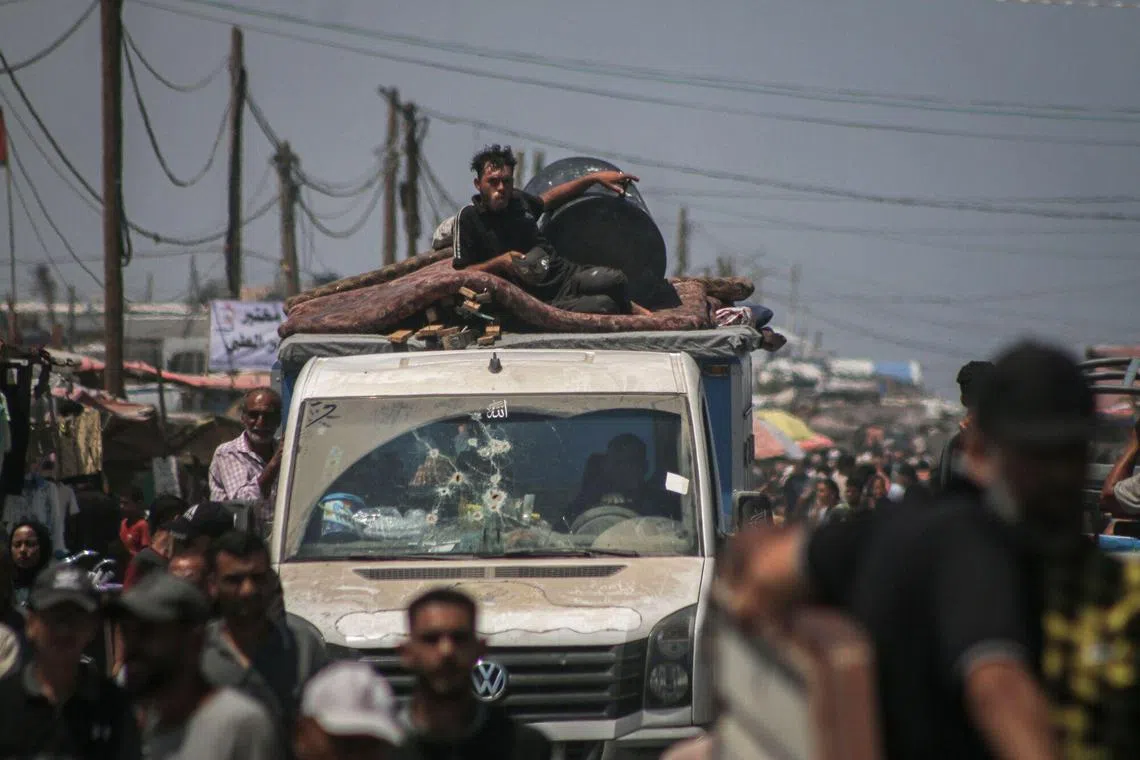Israeli forces push deeper into southern and northern Gaza
Sign up now: Get ST's newsletters delivered to your inbox

Thousands of displaced people from the Shakoush neighbourhood of Rafah are heading northward to nearby Khan Younis.
PHOTO: BLOOMBERG
Follow topic:
CAIRO – Israeli forces deepened their incursion into two northern and southern areas of the Gaza Strip on June 28, and Palestinian health officials said tank shelling in Rafah killed at least 11 people.
Residents and the Hamas media said tanks advanced farther west into the Shakoush neighbourhood of Rafah, forcing thousands of displaced people there to leave their tent camps and head northwards to nearby Khan Younis.
The Israeli military did not immediately comment.
Since May 7, tanks have advanced into several districts of Rafah and forces remained in control of the entire border line with Egypt and the Rafah crossing, the only gateway for most of Gaza’s 2.3 million people to the outside world.
One resident, who spoke to Reuters via a chat app, said some bulldozers in the Shakoush area were piling up sand for Israeli tanks to station behind. “Some families live in the area of the raid and are now besieged by the occupation forces,” he told Reuters.
“The situation there is very dangerous, and many families are leaving towards Khan Younis, even from the Mawasi area, as things became unsafe for them,” said the man, who moved northwards overnight.
More than eight months into Israel’s air and ground war in Gaza triggered by the Hamas-led cross-border attack on Oct 7
The Palestinian groups sometimes still fire rockets into Israeli territory.
Arab mediators’ efforts, backed by the US, have so far failed to conclude a ceasefire.
Hamas says any deal must end the war and include full Israeli withdrawal from Gaza, while Israel says it will accept only temporary pauses in fighting until Hamas, which has ruled Gaza since 2007, is eradicated.
When Hamas-led militants stormed into southern Israel in October, they killed around 1,200 people and seized over 250 hostages, according to Israeli tallies.
The Israeli offensive in retaliation has so far killed more than 37,000 people, according to the Gaza Health Ministry, and has left the tiny, heavily built-up coastal enclave in ruins.
In parallel, Israeli forces continued their new raid into the Shejaia neighbourhood
Medics said earlier that several Palestinians have been killed and wounded in Israeli bombardment, and that medical teams have been unable to reach all casualties because of the military offensive.
The Israeli military said forces were conducting “targeted” raids in Shejaia, adding that the air force struck dozens of Hamas military targets in the area.
It said one Hamas militant, who was operating from a humanitarian-designated area, was killed in a strike it launched in the Deir al-Balah area in central Gaza.
It said measures were taken to ensure no harm to civilians, and it accuses Hamas of systematically using Palestinian civilians as shields, which the militant group denies. REUTERS

